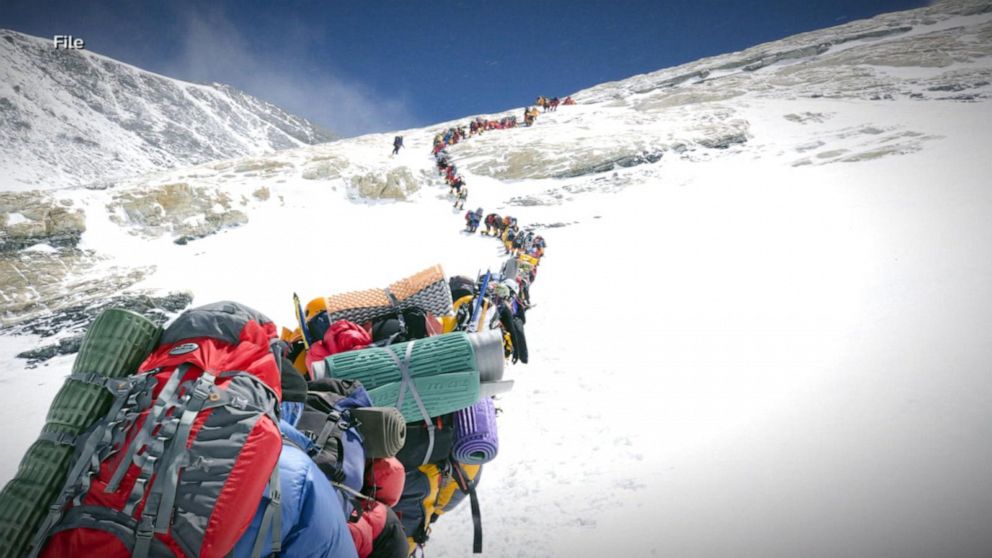
It sounds just like the time I climbed Mount Druitt — without oxygen I might add, although I was assisted. I caught the train.
“Death. Carnage. Chaos. Line-ups. Dead bodies on the route and in tents at camp 4. People who I tried to turn back who ended up dying. People being dragged down. Walking over bodies …”
But no, this is Mount Everest. The world’s tallest mountain.
It was just 66 years ago on this day that Everest’s summit was reached for the first time by Sir Edmund Hillary and Tenzing Norgay at exactly 11.30 in the morning Nepal Time.
Just who got there first was a matter of feverish speculation with a story surfacing that Tenzing had dragged a semiconscious Hillary to the summit. Ultimately Tenzing put the gossip to rest and acknowledged his New Zealand companion was first to scramble up to the top of the highest place on the planet, the peak itself a flat space around the size of a tournament-grade snooker table.
What was the loneliest place on Earth is now like Pitt Street in peak hour.

In calendar terms, the timing of Hillary and Tenzing’s ascent, known as the 1953 British expedition, and the cluster of climbers stepping over corpses and tapping their feet impatiently in a long queue to reach the top today, is no idle coincidence.
There is a narrow window for climbers, just a few weeks in May between the long Himalayan winter and the arrival of the monsoon season.
Most climbers make their way through Nepal and scale the mountain from the south. About a third of all mountaineers attempting the climb make their way to Everest through Tibet or more properly, the Tibet Autonomous Region of the People’s Republic of China.
While those in Nepal trudge for several days with their heavy packs before arriving at Everest’s southern face, those who come to the north face, arrive by bus or truck along a spanking new highway that leads all the way from the Tibetan capital, Lhasa, to base camp.
Anyone who climbs Everest must go as part of an expedition, sherpas must be paid for and climbing licenses, either Nepalese or Chinese must be obtained. The average price per climber is around $80,000.
It’s safe to say a trip to Everest is not a family friendly holiday. Anyone could get their fair share of thrills and spills at the theme parks on the Goldie for a whole lot cheaper and statistically at least, you’re bound to arrive home in one piece.
Climbing Everest ‘because it’s there’ now includes participating in what must be the most dangerous conga line on the planet, shuffling along what’s called ‘The Death Zone’ in an interminable wait, hurdling the dead, before taking the inevitable selfie and starting it all over again on the way down.
I can’t think of a worse place to take a holiday — and I’ve been to Adelaide.
Boldly go where 4000 people have gone before
Broadly speaking, I understand why people choose to climb Everest. It’s part of an all too common recklessness dressed up as bravado. It’s crazy brave eco-tourism where those who don’t die trying, collect the T-shirt and bore people senseless with slide nights after returning home.


Whatever drives these people, it is not the same motivation that took Hillary and Tenzing to Everest’s summit. To boldly go where 4000-odd people have gone before is ego masquerading as accomplishment. You shouldn’t even win a T-shirt for that. A Darwin Award, maybe.
It is said by people of a certain emotional bent that we all have our personal Everest, the largest mountain to climb to overcome some shortcoming or rise above weakness. But the metaphor doesn’t really work these days. Every year, the Nepalese government issues two thousand licences (the Chinese issue about a half of that figure). Not all of those who buy a ticket get to the top, of course, but on those numbers it’s only a matter of time before we’re all prodded up the mountain for a quick selfie.
Our personal Everest is becoming as commonplace as popping around to the shops for the bread and milk.
You want to overcome your demons, Everest isn’t going to cut it anymore. Try space travel. And not that prepaid Virgin Galactic stuff either. Build your own rocket and climb aboard.
It is extraordinary that on the anniversary of Sir Edmund Hillary’s ascent of Mount Everest — a feat that captured the imagination of the world, the mountain itself is a teeming cesspit, part morgue, part toilet.
It’s a measure of how far we’ve come and ironically, how far we’re falling.
This column was first published in The Australian on 29 May 2019
